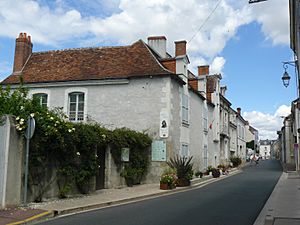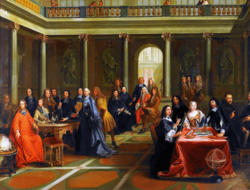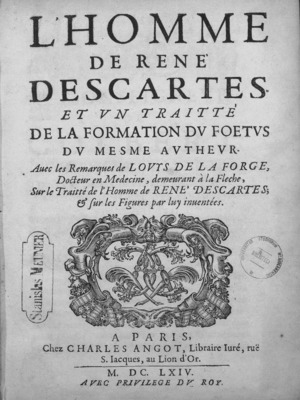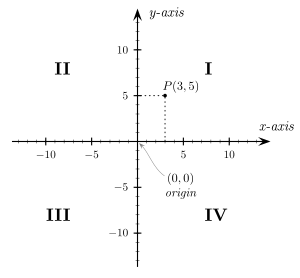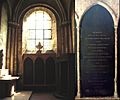René Descartes facts for kids
Quick facts for kids
René Descartes
|
|
|---|---|
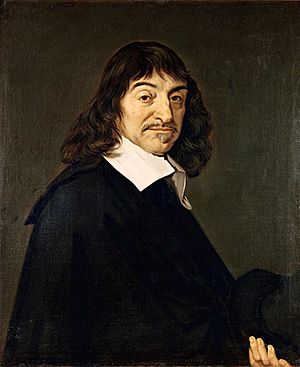
Portrait after Frans Hals
|
|
| Born | 31 March 1596 La Haye en Touraine, Touraine, Kingdom of France (now Descartes, Indre-et-Loire)
|
| Died | February 11, 1650 (aged 53) |
| Education |
|
| Era |
|
| Region |
|
| School |
|
| Thesis | Untitled LL.B. thesis (1616) |
|
Main interests
|
Epistemology, metaphysics, mathematics, physics, cosmology, ethics |
|
Notable ideas
|
See list
|
| Signature | |
René Descartes (born March 31, 1596 – died February 11, 1650) was a famous French philosopher, scientist, and mathematician. He spent much of his life working in the Dutch Republic. He was a very important thinker during the Dutch Golden Age.
Descartes is best known for his philosophical statement: "cogito, ergo sum" which means "I think, therefore I am." This idea suggests that the very act of doubting or thinking proves that you exist.
He believed that the brain worked like a machine. Unlike many people at the time, he thought that math and mechanics could explain even the most complex parts of the mind. His ideas later inspired Alan Turing in computer science. Descartes' theories about reflexes also helped create advanced ideas in physiology more than 200 years after he died. The famous physiologist Ivan Pavlov admired Descartes greatly.
Many people call Descartes the "father of modern philosophy."
Contents
Life of a Great Thinker
Early Years and Education
René Descartes was born in a town called La Haye en Touraine, France, on March 31, 1596. His mother died when he was just one year old. His father was a lawyer. René lived with his grandmother and great-uncle.
In 1607, he went to a Jesuit school called Collège Royal Henry-Le-Grand. There, he learned about math and physics, including the work of Galileo. After school, he studied law at the University of Poitiers from 1615 to 1616, as his father wished.
Descartes later wrote that he stopped studying books. Instead, he decided to learn from himself and the world around him. He spent his youth traveling, meeting different kinds of people, and learning from new experiences.
Joining the Army
In 1618, Descartes joined the Dutch States Army as a soldier. He studied military engineering and learned a lot about math. In the army, he met Isaac Beeckman, a school principal who encouraged him to use math to understand nature.
In November 1619, while in Germany, Descartes had three important dreams. He believed that these dreams showed him a new way of thinking about philosophy. He realized that all truths are connected. If he could find one basic truth, he could use logic to discover all other scientific truths. This led him to his famous idea: "I think, therefore I am."
His Career and Major Works
Life in France and the Netherlands
After leaving the army in 1620, Descartes traveled before returning to Paris. He wrote his first essay on method, called Rules for the Direction of the Mind. In 1623, he sold his property and invested in bonds. This gave him enough money to live comfortably for the rest of his life.
In 1628, Descartes moved to the Dutch Republic. He studied at the University of Franeker and later at Leiden University. He had a daughter named Francine, who sadly died at age 5 from scarlet fever. Descartes was very sad about her death. Some people believe this loss changed his work, making him search for deeper answers about life.
Despite moving often, Descartes wrote all his main works during his 20 years in the Netherlands. He started a big change in math and philosophy. In 1637, he published his famous Discours de la méthode (Discourse on the Method). In this book, he shared four rules for thinking clearly:
The first rule was never to accept anything as true unless I knew it was absolutely true. This means avoiding quick judgments and only believing what is so clear and distinct that there is no room for doubt.
In his book La Géométrie (Geometry), Descartes used his discoveries to create what is now called Cartesian Geometry. This combines algebra and geometry.
He continued to publish important works. In 1641, he wrote Meditations on First Philosophy, which was about metaphysics (the study of reality). In 1644, he published Principles of Philosophy, which brought together his ideas.
Descartes also wrote many letters to Princess Elisabeth of Bohemia. They discussed topics about morals and the mind. In 1649, he published The Passions of the Soul, which he dedicated to the Princess. In this book, he talked about human emotions.
Time in Sweden and His Death
By 1649, Descartes was one of the most famous thinkers in Europe. Queen Christina of Sweden invited him to her court to help start a new science academy and teach her about his ideas. Descartes moved to Sweden in the middle of winter.
Queen Christina wanted to learn from him, but she asked him to give lessons very early in the morning, at 5 am, in her cold castle. This was very hard for Descartes. He got sick with pneumonia and died on February 11, 1650.
Descartes was buried in a graveyard for orphans in Stockholm. Later, his remains were moved to France. Today, his skull is on display in a museum in Paris.
Descartes' Big Ideas
Mind and Body Connection
Descartes explored how the mind and body are connected and how they work together. His idea that the mind and body are separate is called Cartesian dualism. This idea greatly influenced later Western philosophy.
He believed that the mind is a single, complete thing that cannot be divided. According to Descartes, humans are a mix of mind and body. He thought the mind could exist without the body, but the body could not exist without the mind.
Understanding Emotions
In The Passions of the Soul, Descartes talked about "animal spirits." These were thought to be light fluids moving through the nervous system between the brain and muscles. He believed these spirits affected our emotions.
Descartes identified six basic emotions: wonder, love, hatred, desire, joy, and sadness. He argued that these emotions were different combinations of the original "spirit" and made the soul want to do certain actions. He was one of the first scientists to think that the soul could be studied scientifically.
His Views on Animals
Descartes believed that animals did not have reason or a soul like humans. He thought that humans could feel pain and worry, but animals could not. If animals showed signs of distress, he believed it was just a reflex to protect their bodies, not actual suffering.
This view, though not accepted by everyone, became common in Europe. It allowed people to treat animals harshly, as if they were just machines. This idea was part of laws and society until the mid-1800s.
Contributions to Mathematics
Using x, y, z and Exponents
Descartes came up with the idea of using x, y, and z to represent unknown numbers in equations. He also started using small numbers written above, called superscripts, to show powers or exponents. For example, he used x2 for "x squared."
Analytic Geometry
One of Descartes' most lasting contributions was developing analytic geometry. This system uses algebra to describe geometric shapes and positions. He was the first to make algebra a central part of understanding knowledge. This is why we have the "Cartesian coordinate system" with x and y axes.
Influence on Isaac Newton
Many people believe that Descartes had a huge influence on the young Isaac Newton. This is considered one of Descartes' most important contributions to science.
The Start of Calculus
Descartes' work laid the groundwork for calculus, a type of math developed by Leibniz and Newton. Calculus helps us understand how things change. His "rule of signs" is also a common way to find the number of positive and negative solutions in a math problem.
Contributions to Physics
Philosophy, Metaphysics, and Physics
Descartes is often seen as the first thinker to stress using reason to develop natural sciences. For him, philosophy was a complete system of thinking that included all knowledge. He explained it like this:
Thus, all Philosophy is like a tree, of which Metaphysics is the root, Physics the trunk, and all the other sciences the branches that grow out of this trunk, which are reduced to three principals, namely, Medicine, Mechanics, and Ethics. By the science of Morals, I understand the highest and most perfect which, presupposing an entire knowledge of the other sciences, is the last degree of wisdom.
Understanding Motion
Mechanical Philosophy
Descartes' interest in physics began when he met Isaac Beeckman in 1618. Beeckman was a leader in a new way of thinking called mechanical philosophy. This idea suggested that the universe works like a machine. Descartes and Beeckman believed that math and physics should be closely linked.
Conservation of Motion
In his book Principles of Philosophy (1644), Descartes described his three laws of motion. (Later, Newton's own laws were based on Descartes' ideas.) Descartes defined "quantity of motion" as the size of something multiplied by its speed. He believed that the total amount of motion in the universe always stays the same.
If one object is twice as big as another, and moves half as fast, then both objects have the same amount of motion.
[God] created matter, along with its motion ... by letting things run their course, he preserves the same amount of motion ... as he put there in the beginning.
Descartes discovered an early version of the law of conservation of momentum.
Planetary Motion
Descartes also had a "vortex theory" for how planets move. He thought planets were carried around by swirling whirlpools of invisible matter. However, Newton later proved this theory wrong with his law of universal gravitation.
Optics and Light
Descartes also made important discoveries in optics, the study of light. He used geometry and the law of refraction (also known as Descartes' law) to explain why a rainbow has an angular radius of 42 degrees. He also independently discovered the law of reflection, which explains how light bounces off surfaces.
Ideas About Weather
Descartes had ideas about how the elements are made of tiny particles. He thought these particles joined together, leaving small spaces filled with even smaller, faster "subtile matter." These particles were different for different elements. For example, he thought water particles were like "little eels" that could twist around each other but not get stuck.
He believed that when a warm cloud was above a cold cloud, the vapor around the top cloud would condense and fall. When these falling particles hit the bottom cloud, it would create thunder. He compared this to avalanches, where heavy, warm snow falling onto snow below creates a booming sound.
Descartes also thought that lightning was caused by gases trapped between two colliding clouds. He believed that if the weather was hot and dry, these gases would become "fine and inflammable." When the clouds collided, the gases would ignite, creating lightning.
He believed that clouds were made of water and ice drops. Rain would fall when the air could no longer hold them. If the air was cold enough, it would fall as snow. Hail, he thought, happened when cloud drops melted and then froze again in cold air.
Descartes used logical reasoning to come up with his weather theories. He didn't use math or instruments, as they weren't available at the time.
Images for kids
See also
 In Spanish: René Descartes para niños
In Spanish: René Descartes para niños
- 3587 Descartes, asteroid
- Cartesian circle
- Cartesian doubt
- Cartesian materialism (not a view that was held by or formulated by Descartes)
- Descartes number
- Cartesian plane
- Descartes Prize
- Descartes-Huygens Prize
- Cartesian product
- Cartesian product of graphs
- Cartesian theater
- Cartesian tree
- Descartes crater and Highlands on the Moon (Apollo 16 landing site)
- Descartes' rule of signs
- Descartes's theorem (4 tangent circles)
- Descartes' theorem on total angular defect
- Folium of Descartes
- Bucket argument
- Paris Descartes University
- List of things named after René Descartes


